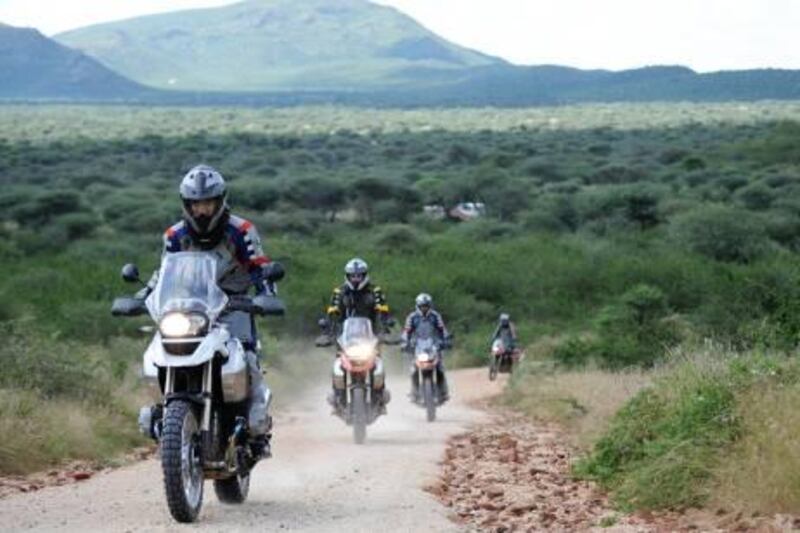I grew up riding dirt bikes. I dreamed about them, read about them and, starting at the tender age of 12, begged for them so assiduously that my parents finally capitulated and bought me my first Honda. I swear I loved that teeny CT70 so much that I would have slept with it in the garage had my parents been just a little less caring.
Weekends would see me waking up early, feeding the little tiddler 25 cents worth of petrol (a half gallon of hi-test; what can I say, I'm old) and then exploring the wilds that are Northern Canada. I would come home only when it was so dark that I knew that my mother would be calling for a police search party. No matter the weather - rain, shine and, yes, even snow - I was out riding the wheels off that poor little Honda. Though it was lost on the narcissism of youth, it was as idyllic an upbringing as can be imagined.
Larger dirt bikes ensued. The jumps got higher, the "whoops" got deeper and I eventually got my first job testing motorcycles at Canada's revered Cycle Canada magazine where, being the low man on the totem pole, I was "in charge" of all off-road testing. To me, of course, that just meant that I could now jump and whoop to my heart's content and - surely this was magic - get paid to do it.
You know the rest of the story. Marriage ensued and, while that didn't take, the job change that it required - testing cars for this fine tome, among others - did and motorcycles, at least of the off-road variety, were put on the back burner. Dirt biking was something I did sporadically; riding opportunities were far and few between. There was a week in Alaska aboard a Kawasaki KLR650 about a decade (and many hair follicles) ago and then nothing with knobby tyres until we had a little fun last year aboard BMWs in Morocco.
This year - and aren't I the lucky one - brought yet another foray to far-off Africa. Again hosted by BMW Motorrad chief executive, Hendrik von Kuenheim, and guided by a South African tour company called Karoo Biking, the plan was to spend an entire week traipsing through far-off Namibia. I couldn't wait. Riding sand dunes, for instance, is something I'd only seen in Dakar Rally television coverage. Riding on sandy beaches? Where I come from, such shenanigans are strictly verboten.
Riding sand dunes turned out to be something perfectly suited to someone like me; short on talent but long on enthusiasm. The trick is to never shut off the gas, no matter how dire the speed wobble or how frighteningly sideways the rear end of the motorcycle slews. Essentially, one attacks the sand dune with all the speed that can be mustered and then never backs off the throttle even a bit, no matter how badly the bike tries to spit you off like a high-speed broncing buck.
Timidity is death. Though it's perfectly natural to react to this profound instability by backing off the gas, this seemingly sensible reaction has two deleterious effects. First, it causes the front wheel to "wag" even more and, secondly, because all your weight has now transferred forward, the front tyre is very likely to "dig in" whereupon the motorcycle stops dead in its tracks. Your momentum, unfortunately, continues unabated, quickly rendering you airborne followed abruptly by a typically unballetic face-plant. Since I was too stupid to slow down, I actually made it to the top with relative ease.
What surprised us all - we were 10 moto-journalists from around the globe - is quite how competent these BMW motorcycles are on this treacherous terrain. For those not familiar with motorcycling, the F800 GS falls into the category of adventure tourers, the concept being motorcycles large enough to be comfortable on the motorway, but with a modicum of off-road ability so that they might "tour" even when the tarmac ends. Normally neither fish nor fowl, they are the SUVs of the two-wheeled world, conscripted to both haul massive amounts of luggage and yet still acquit themselves over difficult terrain.
Usually, it is their off-road abilities that suffer, their weight and on-road pretensions limiting their effectiveness when the road turns dusty. And while I can't tell you that the big BMW is the equal of the lithe, rapier-like Husqvarna TE449 we fooled around with, every single journalist came away amazed at what silliness we could get away with riding the F800 over terrain its designers could only dream about. It was, in fact, easier traipsing up the big dunes aboard the F800 than on the lesser Husky, the 310, we had along. A true marvel of lightweight engineering (the baby TE is claimed to weigh but 105kg; an amazing feat for a dirt bike with both lights and an electric starter). The TE would be an incredible ride on a tight trail, but conquering dunes favours horsepower - lots of it - something the 799cc BMW has in spades.
It's also a bunch better at touring. Indeed, I will affront BMW aficionados by noting that I prefer the smaller F800 over its more renowned, and more powerful, R1200 GS sibling simply because its lighter weight is less taxing to my riding ability. Yes, the lesser BMW carries less luggage. It's also a little less sure-footed when cruising at autobahn-like velocities. But when you're riding upwards of 400 kilometres a day (an easy day in a car on a four-lane motorway; a marathon through a sandy desert on a motorcycle) through Namibia, ease of riding is something that comes in handy.
Because - and even a formerly hard-bitten dirt-biker like Yours Truly can admit this - a large part of this off-roading madness is taking in the sights and new-found delights. Like visiting the Erindi Game Reserve and finding out that a lion's territorial growl is nothing like the "Roar!" portrayed in bad Tarzan movies: Instead, it starts like the beast has the mother of all giant furballs stuck in his throat, morphs into a truly ferocious rasping cough before culminating in something that I swear sounds like the low-rpm bark of an open-piped Nascar V8, only infinitely more guttural and frightening. Or tracking four hunting cheetahs - named Toblerone, Coco-Chanel, Nestlé and Hershey by Erindi's South African guide, Henco, who obviously has a thing for chocolate. Or getting stared down on a trail by a bull giraffe so tall that, if we just scrunched down over the F800's handlebars, I swear we could have ridden under his belly.
Indeed, Africa is full of surprises. The most dangerous animal in the jungle, says Henco, is not the rhinoceros, the elephant or even the aforementioned Lord of the Jungle. It's the hippopotamus which, as placid as it looks bathing mostly submerged under the noon day's sun seems to display quite a temper when it's feeding at night. More humans, it seems, are killed by the giant "river horse" than any other animal in Africa. So much for the Happy Hippo myth.
The other surprise is Namibia itself. A large country - about 824,000 square kilometres in all, about the size of France - it claims only two million inhabitants, making it one of the more sparsely-populated countries in Africa. It's also really hard to imagine a friendlier place. Perhaps it is the delusion of the tourist. Or maybe we just happened to visit the more upscale parts of this oh-so-barren land. But there was virtually none of the strife that commonly fills newspaper headlines when reporting on Africa nor is the countryside plagued by the racial tension so apparent in other areas of Africa. Who knew?
Namibia, though, had one final surprise for me. Despite that misspent youth I mentioned previously, nothing in my youthful dirt-biking prepared me for riding the desert. Canada is cold, damp and snowy and Namibia, well, not so much. We have no sand dunes; they have precious few Douglas fir trees.
Then magic occurred. It turned out that April is Namibia's rainy season. As if on cue, on the last day, the heavens opened up with a deluge that would have impressed Noah. What was once dry and dusty became wet and sodden. What was once dirt became mud. What had been dried river beds became overflowing water crossings. In short, southernmost Africa became northern Canada.
And I was home. Where everyone else was wet, cold and tired, I was in my glory. While everyone else took frequent breaks to warm up, I kept on looking for more sliminess to throttle through. I blasted the F800 through mud bogs praying the GS would actually slither and slide just for the thrill of being out of control. Where less experienced aquanauts dribbled through streams, I splashed through completely oblivious to the fact that I was absolutely soaked to the skin. For a brief few water-soaked hours, I was no longer a 53-year-old with tired lower lumbars and a fastidiously on-time editor.
So, after 36 years, I finally got to go "home" to my dirt-biking roots. Only I had to go to Namibia to do it.






